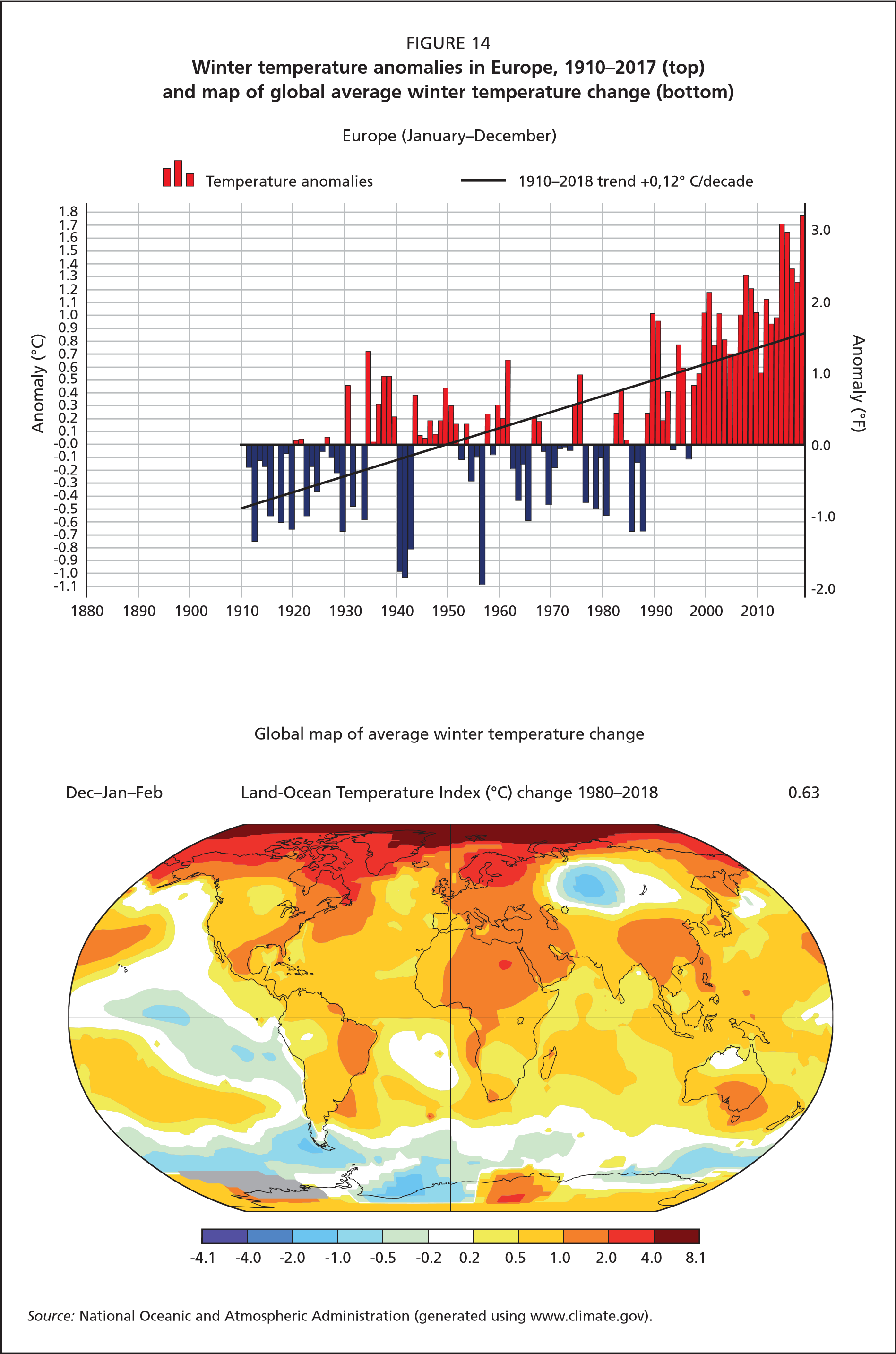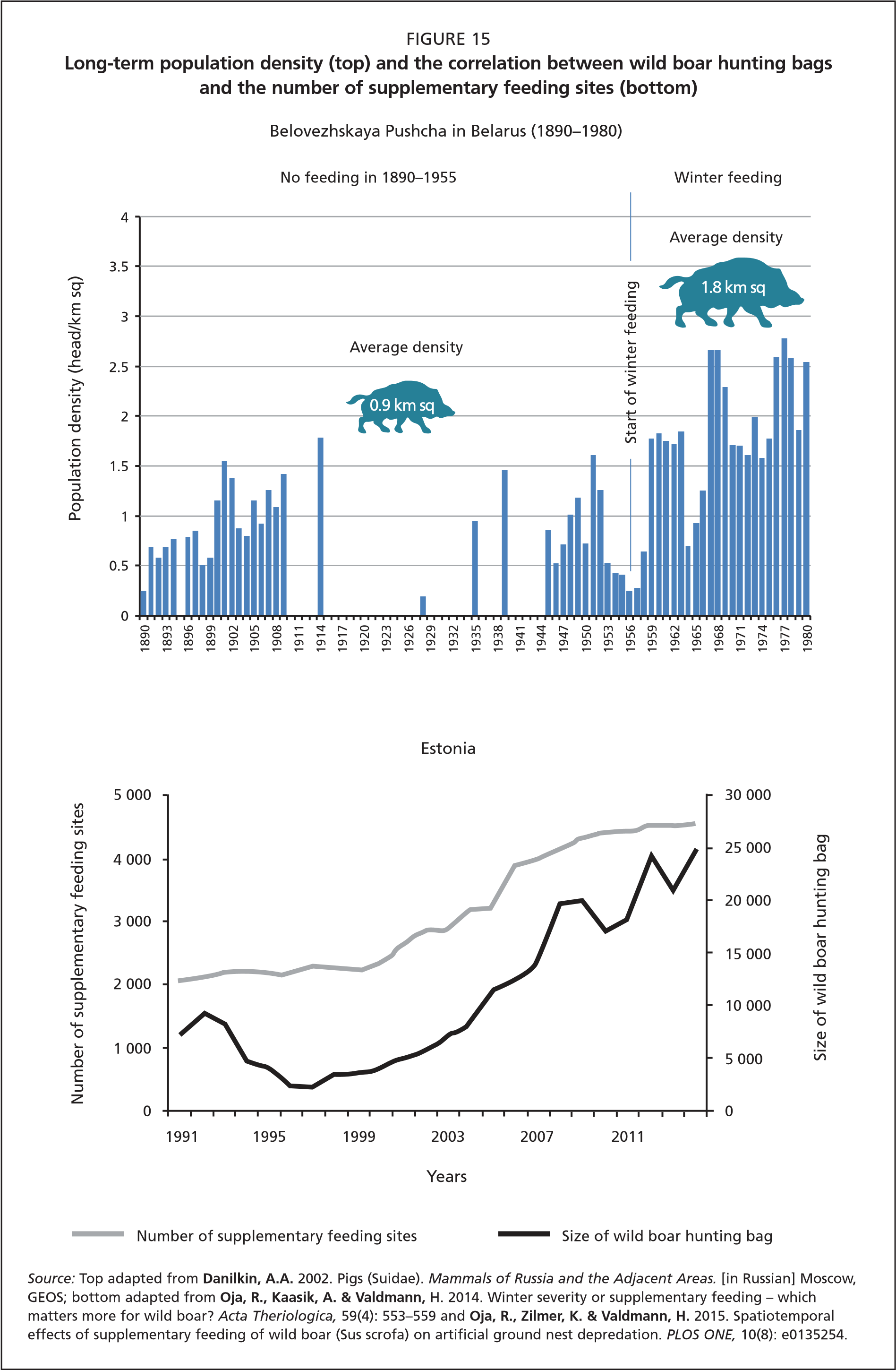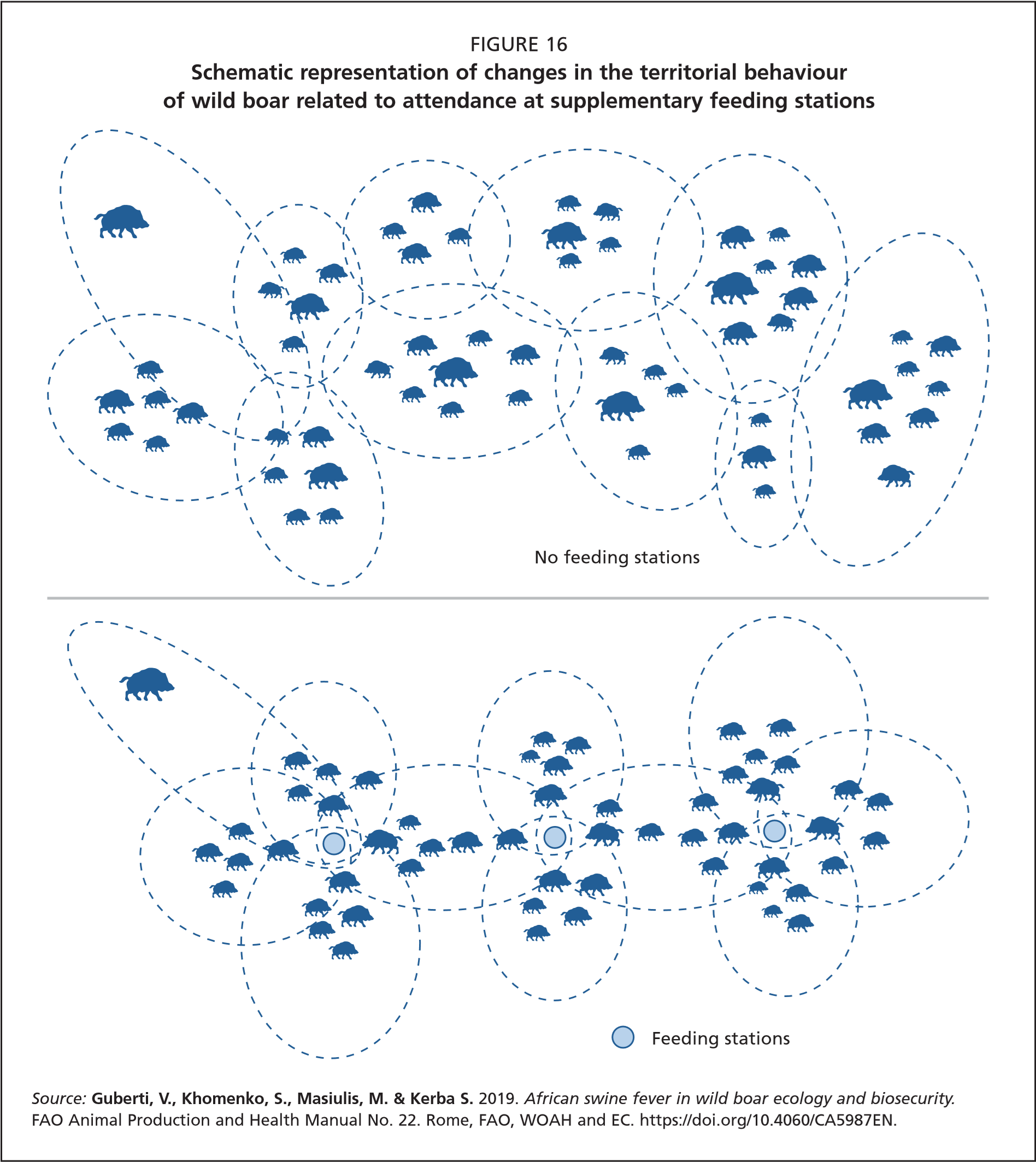African swine fever in wild boar: population increase In Europe

Wild boar have a very high natural reproduction potential. Litter size in this species has a wide range of variation, on average 3–7 and sometimes as high as 11–15, and is the largest among all European ungulates. Litter size largely depends on age (generally smaller in younger females and larger in mature females) and the physical condition of the female. Average litter sizes vary across northern and eastern Europe, and are generally larger in warmer climates. Litter sizes also vary between years, increasing in years following warmer winters and mast (years with abundant production of seeds such as acorns, chestnuts and others which wild boar eat). In addition, animals can extend the duration of their reproduction season well beyond the spring months. Under particularly favourable conditions, they can potentially breed all year round. In some parts of Europe, some females can deliver two litters a year. The participation of a considerable number of first-year females in reproduction is also increasingly common in many European countries, since fertility is related to body mass rather than age; as a result, a larger proportion of females contributes to reproduction.
Although mortality levels in juvenile wild boar are also high, these apparently do not fully compensate for the increased productivity. Wild boar have no natural predators over most of western Europe, while some eastern European populations do experience some level of predation by wolf (Canis lupus). Unless affected by disease such as CSF or tuberculosis (EFSA, 2017), the fertility and survival of wild boar do not seem to be density dependent, and dispersion rates decrease rather than increase with growing numbers (Truvé, Lemel and Söderberg, 2014). Therefore, at the population density levels generally encountered in Europe their population growth does not seem to be self-limiting and is barely controlled by current levels of recreational hunting (Massei et al., 2015).
A number of recent studies suggest that the increase in wild boar populations in Europe is strongly driven by climate change (Vetter et al., 2015), and that this trend appears to be irresponsive to the existing levels of hunting pressure (Massei et al., 2015). Although population growth is reportedly associated with increasingly warmer winter conditions everywhere (Figure 14), its rate was highest in the colder climates (Vetter et al., 2015). Eastern European populations of wild boar were more responsive to favourable changes in winter weather and reached maturity more quickly. Whether this result is due to better adaptation of “northern” wild boar to the cold, or is related to the widespread practice of providing supplementary feed, remains to be investigated. But it is very likely that the winter feeding of animals in colder climates has made a significant contribution to the better survival and reproduction rates of wild boar and should be considered in the analysis of population growth.
In general, supplementary feeding means that additional food is provided for wild animals in their natural habitat. For wild boar, supplementary feeding is done for a number of reasons, including to keep animals away from crops, to attract them to particular locations for hunting, or just to fully support their nutritional needs on a year-round or seasonal basis. Supplementary feeding is commonplace across northern and eastern Europe, but it is not well documented, and until recently was not properly regulated. Research has shown that supplementary feeding on the scale it currently occurs in many European countries is excessive, particularly in view of the sustained decrease in the severity of winters, and significantly contributes to the increase of wild boar populations.
The impact is strongest in eastern Europe, where provision of winter food has long been promoted as a key aspect of game management. Long-term observations such as, for example, those conducted in Belovezhskaya Pushcha in Belarus from 1890 to 1980 (i.e. before recent climate warming could have had a significant positive effect on population dynamics), illustrate that the provision of food in winter was capable of doubling average population density (Figure 15).


Supplementary feeding has been shown to seriously interfere with conservation of other species and habitats, including protected nature reserves and national parks. In many countries, regular provision of food to wild boar develops into commercial game farming aimed at increasing revenues, utilizing the unlimited population growth potential of this species. Supplementary feeding can be provided on a year-round basis (Photo 2 and Photo 3), and can consist not only of cereals or root vegetables, but also of expired or unsold foodstuffs from shops. Some hunting grounds grow crops such as potato or maize especially to feed wild boar, and keep them from raiding commercial fields and residential gardens.
The chain of negative implications for population management of wild boar due to unbalanced or excessive supplementary feeding can be generically summarized as follows.
Wild boar habitat use is modified because of feeding, and hunting grounds attract more animals. Feeding increases winter survival chances, thus reducing natural selection, and will maintain females in required threshold of body mass necessary to reproduce, around 27–33 kg live weight (Servanty et al., 2009).
As a result of supplementary feeding, the general fertility rate may double, and the average proportion of young animals significantly increases at the population level. Such an elevated population surplus due to favourable environmental conditions would be likely only once in 3–4 years naturally, but in the populations receiving regular supplementary feeding, animals enjoy “good years” every year (Groot Bruinderink, Hazebroek and Van Der Voot, 1994). Artificial feeding reduces or completely negates the natural regulatory effect of limited food availability in winter, which is when most wild boar mortality should naturally occur. An extended maintenance of this practice over years leads to an increase of population density beyond the carrying capacity of the natural environment and drives emigration of animals to neighbouring areas, which is often counterbalanced by provision of even more supplementary food.
Wild boar take advantage of seasonally abundant natural feed, such as cereals, acorns, beechnuts or other valuable foods. Therefore, another very important implication of supplementary feeding is that it significantly changes the behaviour, territorial structure and patterns of social interaction in the population. This effect is particularly common in the colder climates during cold spells and snowy weather.
Feeding sites become regularly attended by several family groups of animals, and some animals or groups visit more than one, even in a single day. Both direct and indirect contact occurs, whether among groups feeding at the same time, or between groups attending the same feeding site (Figure 16). Such space-use patterns particularly intensify during winter when more food is given to animals both to support their diet and to prepare them to be used for hunting. Rates of interaction are much higher than they would normally be in the population without supplementary feeding, increasing the risk of the transmission of infections, including ASF.
Studies have shown that the practice of supplementary feeding results in increased risk of contamination of feeding sites with endogenous parasites (Oja, Kaasik and Valdmann, 2014; Oja, Zilmer and Valdmann, 2015). Historically, in eastern Europe, most devastating outbreaks of CSF in wild boar were associated with local overabundance of animals and increased interaction rates, both of which often resulted from supplementary feeding or under natural conditions during mast years (Danilkin, 2002).
Current understanding of the epidemiology of ASF suggests that inflated and clustered populations of wild boar maintained under regular supplementary feeding are more susceptible to invasion of the virus which finds higher Nt density (see chapter 1) and, therefore, can spread more easily (Sorensen, van Beest and Brook, 2014). Moreover, once introduced, the disease has better chances of developing into a persistent problem in the areas where networks of feeding sites exist. This is driven not only by the more frequent interactions and indirect contacts between live animals, but also by heavy contamination of the environment with the virus and accumulation of carcasses of dead animals which remain infective for long periods of time.

The risk of ASF and its devastating effects on wild boar and the swine industry are not the only reasons for improving the way the hunting community manages wild boar in regions overpopulated by them. Growing numbers of wild boar are increasingly regarded as a problem for agriculture, forestry and wildlife conservation (Massei, Roy and Bunting, 2011). They cause many transport collisions, particularly in western and central Europe, but also in some eastern European countries. At the same time, wild boar are an important economic resource for many landowners and hunting organizers and are important game for many hunters
The emergence and spread of ASF from 2007 to 2017 has provided an extra justification to consider wiser and more sustainable management solutions for the wild boar problem. Their considerable involvement in the transmission cycle of ASF in parts of Europe (see chapter 1) is a new and escalating challenge for the veterinary services of the affected countries. Although it is not clear if and how much population control can help, there are expectations that lowering wild populations through changing hunting management approaches could slow down its geographical spread and help reduce the risk of introduction of the virus into the pig production sector and will reduce the cost of managing ASF in the field. There is little doubt that the spread of ASF in Europe will remain a threat to the pig production sector and will complicate hunting-sector operations for quite some time. These problems do not have a simple and quick solution, and likely require long-term changes to the wildlife management paradigm and practice.
Countries affected by the disease have already adopted some decisions aimed at reducing or stabilizing wild boar numbers, which have several implications for hunters and hunting or wildlife management authorities. It is important that the aims, purpose and rationale behind suggested management solutions are well understood and accepted by hunters. It also needs to be recognized that the problem of ASF negatively affects hunters, as well as local companies that produce different products from the wild boar shot in local areas. Therefore, it is reasonable to have a broad perspective when addressing issues related to ASF, including an exploration of the various ways hunters might be compensated for losses.
Chapter 2 key messages
- Recent expansion of wild boar and reoccupation of their historical range in Europe is a result of multiple factors acting synergistically (climate, agriculture, management, protection).
- Efforts are needed to standardize and improve monitoring of wild boar populations across Europe as a baseline prerequisite for more sustainable management of this species and effective control of diseases such as ASF.
- Large between-year variations in numbers of wild boar are a normal feature of their demography as a species adapted to fluctuating resources and harsh climates.
- Some parts of Europe have better climatic and environmental conditions for wild boar (which generally have winter temperatures) and can sustain large population densities of this species.
- Climate change and excessive supplementary feeding are two major factors that are likely to account for local overabundance of wild boar.
- The practice of supplementary feeding under climatic conditions that are becoming increasingly more favourable for the survival and reproduction of wild boar should be reconsidered and abandoned where the wild boar population has increased too much.
- Wiser game management and better population control can contribute to reducing risks related to the spread of ASF by wild boar, for which an understanding of the aims, objectives and principles of proposed disease control interventions by hunters and game managers are of paramount importance.
Read also
Write to us
Our manager will contact you soon



